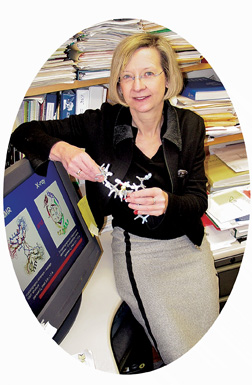Pitt Medical School’s Gronenborn Elected A Member of National Academy of Sciences

Angela M. Gronenborn, the Rosalind Franklin Professor and chair in the Pitt School of Medicine’s Department of Structural Biology, has been elected a member of the National Academy of Sciences (NAS).
NAS is a private organization of scientists and engineers established by Congress in 1863 to act as an official adviser to the federal government, upon request, in any matter of science or technology. Today, the NAS brings together committees of experts to address critical national issues in all areas of science and technology and to advise the federal government and the public based on their analyses.
“It is gratifying that the National Academy of Sciences has recognized the importance of Dr. Gronenborn’s contribution to the field of structural biology and, in doing so, the importance of the field of structural biology to making major advances in biomedical research and medicine,” said Arthur S. Levine, Pitt senior vice chancellor for the health sciences and dean of the University’s School of Medicine.
Structural biologists use powerful, highly sophisticated technologies, such as x-ray crystallography, electron microscopy, and nuclear magnetic resonance (NMR) spectroscopy, to reveal the three-dimensional structures of proteins and other important biomolecules. In recent years, structural biology has become an increasingly important aspect of the drug-discovery process.
Prior to coming to Pitt in 2004, Gronenborn was chief of the structural biology section in the Laboratory of Chemical Physics at the National Institute of Diabetes and Digestive and Kidney Diseases (NIDDK). She is considered one of the world’s leading experts in NMR spectroscopy.
Gronenborn received bachelor’s and master’s degrees in chemistry and, in 1978, a doctorate in organic chemistry, summa cum laude, from the University of Cologne in West Germany. She received postdoctoral training at the National Institute for Medical Research in London from 1978 to 1979, and subsequently became a member of the scientific staff in the Divisions of Molecular Pharmacology and Physical Biochemistry from 1979 to 1984. In 1984, she moved to the Max-Planck Institute for Biochemistry in Munich as head of the Biological NMR Group, and in 1988 she was appointed a senior investigator in the Laboratory of Chemical Physics at NIDDK. She was named chief of the laboratory’s Structural Biology Section in 1991.
Gronenborn is an elected fellow of the Royal Society of Chemistry, the Washington Academy of Sciences, and the American Association for the Advancement of Science. She also is an elected member of the Council of the International Society of Magnetic Resonance, the major international body of scientists pursuing magnetic resonance spectroscopy. She has authored or coauthored more than 360 scientific publications and speaks regularly at prestigious national and international meetings.
She was one of 72 new members and 18 foreign associates from 12 countries elected at the 144th annual meeting of the NAS last week. The new members, who were chosen in recognition of their distinguished and continuing achievements in original research, bring the total number of active NAS members to 2,025. Foreign associates are nonvoting members of the academy, with citizenship outside the United States.
Other Stories From This Issue
On the Freedom Road

Follow a group of Pitt students on the Returning to the Roots of Civil Rights bus tour, a nine-day, 2,300-mile journey crisscrossing five states.
Day 1: The Awakening
Day 2: Deep Impressions
Day 3: Music, Montgomery, and More
Day 4: Looking Back, Looking Forward
Day 5: Learning to Remember
Day 6: The Mountaintop
Day 7: Slavery and Beyond
Day 8: Lessons to Bring Home
Day 9: Final Lessons

